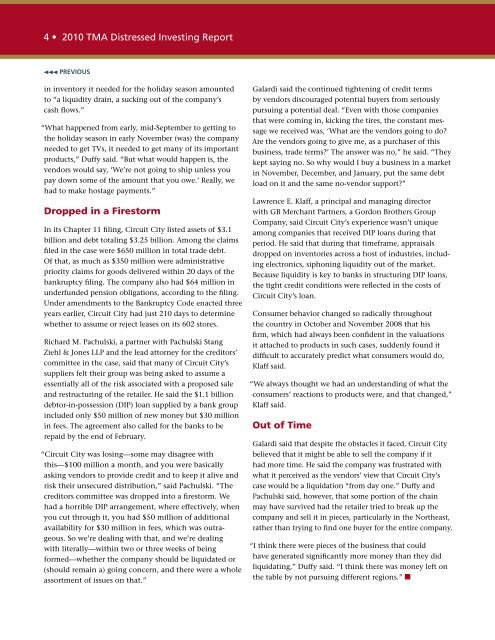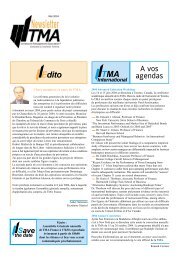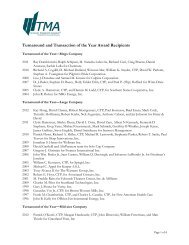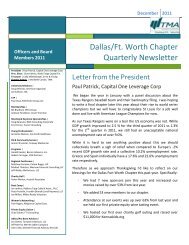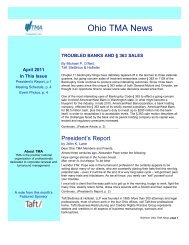Distressed Investing Report - Turnaround Management Association
Distressed Investing Report - Turnaround Management Association
Distressed Investing Report - Turnaround Management Association
Create successful ePaper yourself
Turn your PDF publications into a flip-book with our unique Google optimized e-Paper software.
4 • 2010 TMA <strong>Distressed</strong> <strong>Investing</strong> <strong>Report</strong><br />
nnn PREVIOUS<br />
in inventory it needed for the holiday season amounted<br />
to “a liquidity drain, a sucking out of the company’s<br />
cash flows.”<br />
“What happened from early, mid-September to getting to<br />
the holiday season in early November (was) the company<br />
needed to get TVs, it needed to get many of its important<br />
products,” Duffy said. “But what would happen is, the<br />
vendors would say, ‘We’re not going to ship unless you<br />
pay down some of the amount that you owe.’ Really, we<br />
had to make hostage payments.”<br />
Dropped in a Firestorm<br />
In its Chapter 11 filing, Circuit City listed assets of $3.1<br />
billion and debt totaling $3.25 billion. Among the claims<br />
filed in the case were $650 million in total trade debt.<br />
Of that, as much as $350 million were administrative<br />
priority claims for goods delivered within 20 days of the<br />
bankruptcy filing. The company also had $64 million in<br />
underfunded pension obligations, according to the filing.<br />
Under amendments to the Bankruptcy Code enacted three<br />
years earlier, Circuit City had just 210 days to determine<br />
whether to assume or reject leases on its 602 stores.<br />
Richard M. Pachulski, a partner with Pachulski Stang<br />
Ziehl & Jones LLP and the lead attorney for the creditors’<br />
committee in the case, said that many of Circuit City’s<br />
suppliers felt their group was being asked to assume a<br />
essentially all of the risk associated with a proposed sale<br />
and restructuring of the retailer. He said the $1.1 billion<br />
debtor-in-possession (DIP) loan supplied by a bank group<br />
included only $50 million of new money but $30 million<br />
in fees. The agreement also called for the banks to be<br />
repaid by the end of February.<br />
“Circuit City was losing—some may disagree with<br />
this—$100 million a month, and you were basically<br />
asking vendors to provide credit and to keep it alive and<br />
risk their unsecured distribution,” said Pachulski. “The<br />
creditors committee was dropped into a firestorm. We<br />
had a horrible DIP arrangement, where effectively, when<br />
you cut through it, you had $50 million of additional<br />
availability for $30 million in fees, which was outrageous.<br />
So we’re dealing with that, and we’re dealing<br />
with literally—within two or three weeks of being<br />
formed—whether the company should be liquidated or<br />
(should remain a) going concern, and there were a whole<br />
assortment of issues on that.”<br />
Galardi said the continued tightening of credit terms<br />
by vendors discouraged potential buyers from seriously<br />
pursuing a potential deal. “Even with those companies<br />
that were coming in, kicking the tires, the constant message<br />
we received was, ‘What are the vendors going to do?<br />
Are the vendors going to give me, as a purchaser of this<br />
business, trade terms?’ The answer was no,” he said. “They<br />
kept saying no. So why would I buy a business in a market<br />
in November, December, and January, put the same debt<br />
load on it and the same no-vendor support?”<br />
Lawrence E. Klaff, a principal and managing director<br />
with GB Merchant Partners, a Gordon Brothers Group<br />
Company, said Circuit City’s experience wasn’t unique<br />
among companies that received DIP loans during that<br />
period. He said that during that timeframe, appraisals<br />
dropped on inventories across a host of industries, including<br />
electronics, siphoning liquidity out of the market.<br />
Because liquidity is key to banks in structuring DIP loans,<br />
the tight credit conditions were reflected in the costs of<br />
Circuit City’s loan.<br />
Consumer behavior changed so radically throughout<br />
the country in October and November 2008 that his<br />
firm, which had always been confident in the valuations<br />
it attached to products in such cases, suddenly found it<br />
difficult to accurately predict what consumers would do,<br />
Klaff said.<br />
“We always thought we had an understanding of what the<br />
consumers’ reactions to products were, and that changed,”<br />
Klaff said.<br />
Out of Time<br />
Galardi said that despite the obstacles it faced, Circuit City<br />
believed that it might be able to sell the company if it<br />
had more time. He said the company was frustrated with<br />
what it perceived as the vendors’ view that Circuit City’s<br />
case would be a liquidation “from day one.” Duffy and<br />
Pachulski said, however, that some portion of the chain<br />
may have survived had the retailer tried to break up the<br />
company and sell it in pieces, particularly in the Northeast,<br />
rather than trying to find one buyer for the entire company.<br />
“I think there were pieces of the business that could<br />
have generated significantly more money than they did<br />
liquidating,” Duffy said. “I think there was money left on<br />
the table by not pursuing different regions.” ¬


